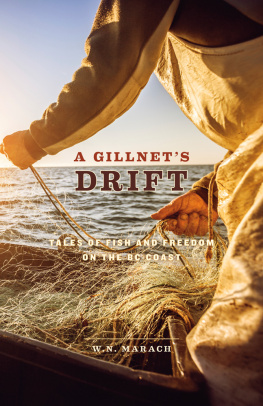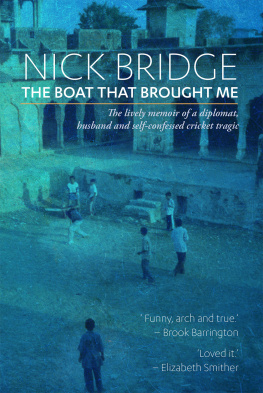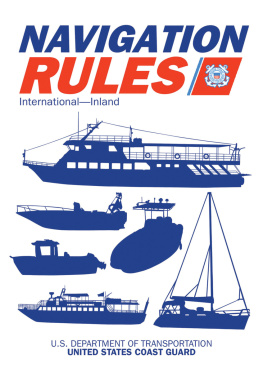THE HASTY PURCHASE
One Friday morning in the spring of 1972, an ad appeared in the Vancouver Sun offering a gillnetter for sale. It caught my eye, not because I wanted to go fishing, but because I was looking for a boat to live on, and the price was cheap.
I was just back in Vancouver after three years away. The first half of that time Id been working in Toronto, and the second half Id spent travelling. A recently graduated architect, Id gone to find some meaning in my profession after the letdown of working in the real world. I didnt have an itinerary or a schedule for my search, but I did have a 1952 BSA motorcycle, bought on impulse in a village near Bath, England, where I had gone to see the ancient Roman ruins. Id learned to ride it in the street in front of the sellers house, and had ridden it through Europe and part of North Africa before selling it in Rome. Each day brought new adventures, but no enlightenment or the meaning Id gone looking for. What I did decidemaybe from seeing the converted barges along the Thames embankment or as a reaction to dry camping on the edges of the Tunisian Sahara or merely from experiencing the total freedom of the roadwas to live on the water when I got back to Vancouver.
Within a week of getting back, I landed a job with one of the better architectural firms in Vancouver. Their office was in an old house, supposedly a former brothel, on Fairview Slopes. The staff lounge was on the top floor with spectacular views over False Creek and downtown. Although starting time was nine oclock, a few of us came in early to have coffee in the lounge and read the morning papers before getting down to work.
As was already our routine, my friend Blake had made the first pot of coffee. I poured cups for both of us and pointed out the ad to him. I didnt know anything about gillnetters, and was going on price only. For once, it was in a range I could afford. Blake was the resident expert on things the average architect didnt know much about, fishboats being one of those things. His knowledge of boats was from his boyhood when hed fished with an uncle who was a gillnetter on the Fraser River.
Have a look. If you like it, offer him half of what hes asking, he said.
Looks like its already about half the price of other gillnetters Ive seen in here, I told him.
Doesnt matteroffer half. You can always come up.
I dont want to insult the guy.
Are you kidding? Its only their wives and girlfriends you can insult fishermen about, not stuff like that. Besides, maybe theres something wrong with it, he said.
I called the owner during my lunch break. He said the boat was up on the dry in the BC Packers yard in Steveston, and its name was the T.K. The name was a little disappointing, and I was surprised to hear him say its instead of her when referring to the boat. Id always thought that any vessel larger that a rowboat was referred to in the feminine. It was my first subtle clue that gillnetters were a little different.
Still on my lunch break, I went to the bank for money. I asked the teller for as many hundred-dollar bills as she had to make my offer more impressive. My father used to say having cash on hand always gave you the advantage in a deal. Remembering Blakes advice, I separated the money into two halves. My plan was to start by offering less than half the asking price and work up from there if I had to. If the boat looked to be a fantastic deal at the asking price, I could always go into the other half of the money, stashed in the inside pocket of my jacket, to improve my offer. If the owner wouldnt accept, or if there was something wrong with it as Blake had suggested, Id keep looking.
The withdrawal nearly cleaned out my account. I left the bank wondering if I was doing the right thing.
Leaving work right at quitting time, I drove out to the boat yard where the owner had said the T.K. was stored. There were plenty of spaces in the parking lot at that time of the day. I got out and went through the gate into a yard that looked to be about an acre in size. From the few boats still braced up on timbers, I gathered that there had been rows of them stored for the winter and then re-floated for the fishing season. The T.K. wasnt among the vessels on these timbers. In the far corner of the yard there were another ten boats blocked up in a row. The T.K. was among those.
As I got closer, I was surprised at how big the boats seemed, braced up on the timbers. The bows stood nearly twice my height, and their sterns, most with some sort of rollers on them, nearly as high. All of them were wooden boats, some with the planks showing quite clearly through their paint. Nailheads and even plank ends had popped out in several of the hulls. The hull on the T.K. was smooth and clean by comparison. It looked freshly painted. Two of the boats had square sterns while the others were pointed at both ends. From what I remembered of Blakes lecture on fishboats, these were called double-enders. Gillnetters preferred double-enders, he explained, because they wouldnt pull nets out of shape in a running tide as quickly as boats with square sterns would. Looking at the two different types of hulls, I thought I could see what he meant. That was the T.K.s first good point, although it shouldnt have mattered since all I was looking for was a live-aboard.
Lying on the ground between the boats was an old, paint-spattered, wooden ladder. I stood it against the side of the T.K. and climbed up to have a closer look. The front part of the boat had a low cabin rising out of the deck and a small wheelhouse. The cabin had round portholes on the sides and a small hatch fitted with a skylight. The wheelhouse had windows along the sides and front. Both the cabin and wheelhouse had nicely arched roofs with walls that were rounded in front and curved along the sides to follow the sheer line of the hull. Roof edges were trimmed with a bull-nosed hardwood cap, forming a curve in both vertical and horizontal planes that seduced the eye. The boat was white with dark green decks and trim. The layers of paint slapped on over the years couldnt hide the builders flawless joinery. It brought back memories of my father in his carpentry shop with wood shavings on the floor as he made things like chairs and fret saws by shaping wood into difficult curves, which showed the joy he took in doing so.
The back part of the boat was obviously the business end. On the deck behind the wheelhouse, there was a canvas-covered hatch over what I assumed was a fish hold. On a solid-looking timber frame beyond that was a large wooden reel. According to Blakes lecture, that was called a drum and it held the net. Bolted to the frame alongside the drum was a large cast iron device that drove it. This was called a drum drive, Blake had said, and the best were Easthopes. I looked closely; there was the Easthope name cast into the side of the drive: yet another point to the good for the T.K. It was dawning on me that although all I was looking for was a live-aboard, if the boat came with all the parts needed to go gillnetting, it was an option I might considerif I ended up the new owner.
There was a payphone at the gate to the storage yard, so I called the owner of the boat. He was showing me through it a half hour later. It was cramped, and I had to stoop in the forward cabin, but everything I needed was there: stove, bunk, storage lockersagain with the nice joineryand a four-cylinder Gray Marine engine, painted candy-apple red. When I asked about the head, the owner said it was to gillnetter standards: a galvanized bucket with a short piece of rope attached to the handle. It spent the winter upended on the engine exhaust, keeping the rainwater out. He took it down so I could try the engine.
A few cranks of the starter had it running. It was surprisingly smooth for an engine that hadnt run for a while. We shut it down quickly to avoid overheating since the engine coolant ran through a keel cooler that needed to be underwater to work. The sound of that engine had me pretty much sold. All there was left to know was why he was selling the boat. The answer was plausible: he had become a fireman. It was what hed always wanted to do, even more than fishing. Unfortunately, becoming a firefighter didnt leave him enough time to fish. As much as he regretted it, the boat had to go.











